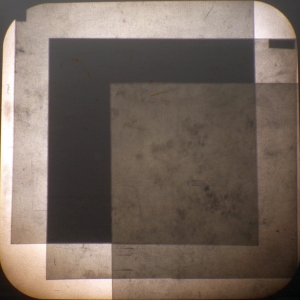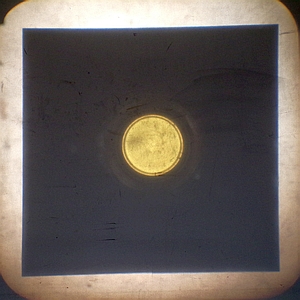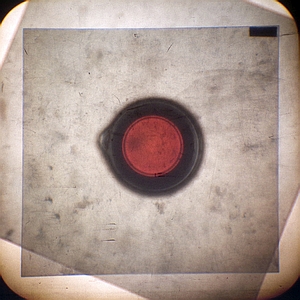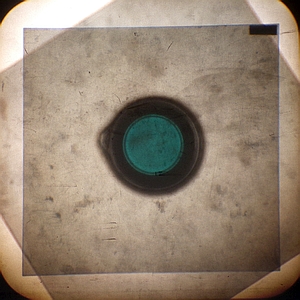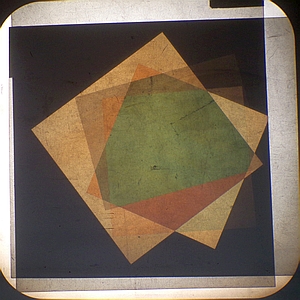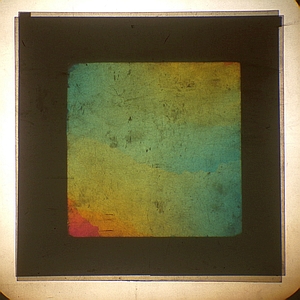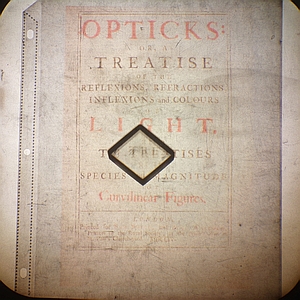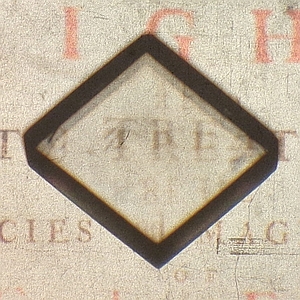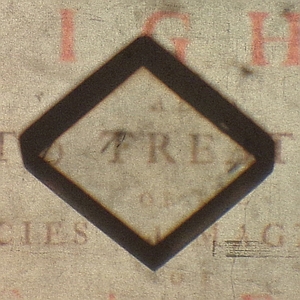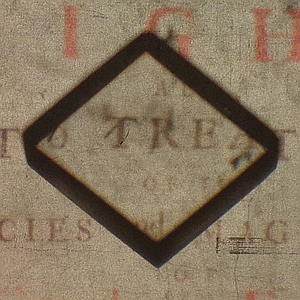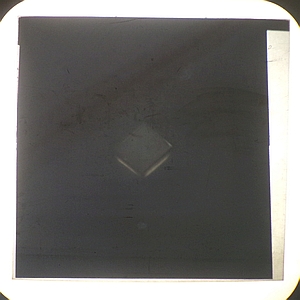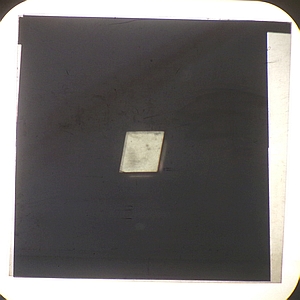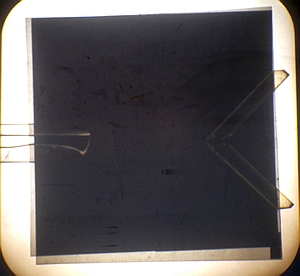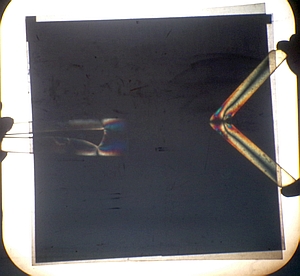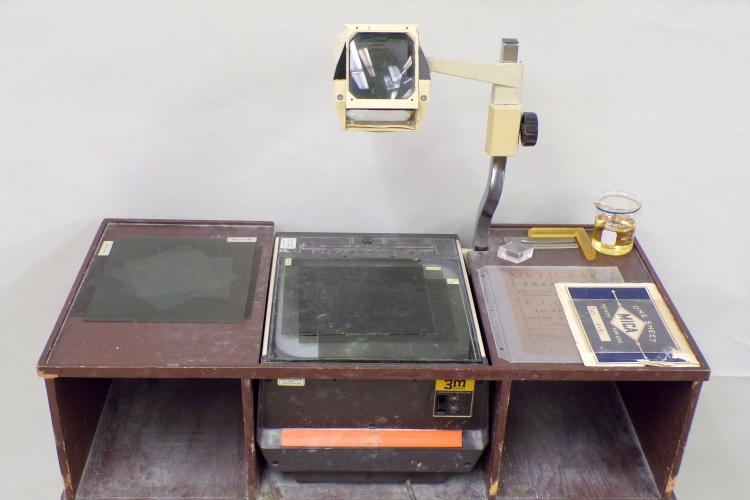
At center on the overhead projector shown above, are two polaroid sheets set at 90 degrees with a third, cut at 45 degrees to its easy axis, slipped between them. At left are two polaroid sheets set at 90 degrees, with pieces of cellophane sandwiched between them, and at right are a block of calcite, two plastic pieces, a beaker of corn syrup, a transparency of the title page of Newton’s Opticks, and a six-inch square of mica. With these you can demonstrate the polarization of (randomly polarized) light, birefringence (double refraction), polarization rotation and various phenomena that result from them.
Light is an electromagnetic wave. This is a transverse wave that comprises an electric field and a magnetic field, both oscillating in phase, perpendicular to each other and to the direction in which the wave travels. (See this page at HyperPhysics for an illustration.) It is common to refer to the oscillating electric field as the electric vector, which lies in the plane of oscillation and points perpendicular to the direction in which the wave travels. If light has its electric vector pointing in a specific direction, it is said to be linearly polarized. Since the light travels in the direction perpendicular to the oscillation, it is also said to be plane polarized. Unless the light source has special properties, the light emitted by most sources has its electric vector oriented randomly in all directions. That is, the intensity is uniform in all directions perpendicular to the direction in which the light is traveling. It is said to be unpolarized. It is possible to select light that is polarized in a particular direction, either by reflection at Brewster’s angle as shown in demonstration 84.39 -- Polarization of reflected light, or by passing it through a material that has special optical properties. (Light is also partially polarized by scattering, as shown in demonstration 84.45 -- Sunset.) In this demonstration, you can show what happens to light when you pass it through polaroid sheets (polarizers), crossed polarizers with a beaker of corn syrup between them, crossed polarizers with layers of cellophane between them, a mica sheet between crossed polarizers, a calcite crystal (with a polarizer above, or between crossed polarizers; vide infra), and stressed pieces of plastic between crossed polarizers.
1) Polaroid sheets (polarizers):
Perhaps the most common material used to make polarizing sheets is stretched polyvinyl alcohol doped with iodine. Stretching the material aligns the polymer chains so that they all run parallel to each other. The iodine that is then added to the material forms linear chains of iodine molecules within the chains of polyvinyl alcohol. This thin polymer layer is then sandwiched between clear layers of cellulose triacetate or similar plastic. (See, for example, here or here.) The chains of iodine-doped polymer interact strongly with light whose electric vector is parallel to them, but not at all with light whose electric vector is perpendicular to them. Thus, light whose electric vector is parallel to the polymer chains is absorbed or blocked, and light whose electric vector is perpendicular to them passes through. The direction along which the electric vector lies for light that the polarizer allows to pass, is called the easy axis of the polarizer. Light whose electric vector is perpendicular to the easy axis is blocked by the polarizer. If the electric vector is neither parallel nor perpendicular to the polarizer’s easy axis, it is resolved into two components, one parallel to the easy axis, and one perpendicular to it. If we call the electric vector E, and set the easy axis vertical, then these components are, respectively, Ey, whose magnitude is E cos θ, and Ex, whose magnitude is E sin θ, where θ is the angle between the electric vector and the easy axis. For unpolarized light approaching the polarizer, all of the vertical (y) components pass through, but all of the horizontal (x) components are blocked. The light that exits the polarizer is vertically polarized; its electric vector points only in the vertical direction. If we now take a second polarizer and place it after the first one, if we start with the easy axis of the second polarizer parallel to that of the first one, all of the light coming from the first polarizer is transmitted by the second one. As we rotate the second polarizer, the intensity of the light transmitted by it decreases until, when the easy axes of the two polarizers are perpendicular, it is essentially zero. As we continue to rotate the second polarizer, the intensity begins to increase, until when the easy axes of the polarizers are again parallel, it is at its original (maximum) value. As we continue to rotate the second polarizer, the intensity again decreases until, when the two easy axes are again perpendicular, it is essentially zero, and again rises until, when the easy axes are again parallel, it is at its maximum value. If we call the amplitude of the electric vector of the light transmitted by the first polarizer Em, then the amplitude of the light transmitted by the second polarizer is E = Em cos θ, where θ is the angle between the easy axes of the two polarizers. The intensity of the light is proportional to the square of the amplitude. If we call the intensity of the light coming through the first polarizer Im, then the light transmitted by the second polarizer is
I = Im cos2 θ
This equation is known as Malus’ law, after Étienne Louis Malus, who discovered it in 1809.
The photograph below shows light coming through a pair of polarizers whose easy axes are set perpendicular to each other, with a third polarizer, whose easy axis is set at 45 degrees to those of the other two, slipped between them.
The bottom polarizer allows only vertically polarized light through, and thus transmits half of the light incident upon it. The top polarizer allows only horizontally polarized light through, and thus transmits half the light incident upon it. Where the two overlap, no light can get through, since the bottom polarizer absorbs the horizontally polarized light, and the top polarizer absorbs the vertically polarized light transmitted by the bottom polarizer. If we place a second polarizer above the bottom polarizer so that its easy axis lies at 45 degrees to the easy axis of the bottom polarizer, the vertically polarized light transmitted by the bottom polarizer now has a component that is parallel to the easy axis of this second polarizer. In agreement with Malus’ law, this component is half the intensity of the vertically polarized light incident on the second polarizer. The light passing through the second polarizer is thus one-quarter the intensity of the light incident on the bottom polarizer. It is also polarized at 45 degrees to the easy axis of the top polarizer, and so has a component parallel to that axis, which is, again, half the intensity of the light incident on the top polarizer. Thus, where all three polarizers overlap, horizontally polarized light emerges, of one-eighth the intensity of the light incident on the bottom polarizer. Hence the pattern in the photograph above, in which we see light areas where individual polarizers block half the light coming from the projector, a dark L-shaped area where the top and bottom polarizers overlap and no light gets through, a lighter rectangular area where the polarizer whose easy axis is at 45 degrees sits between the top and bottom polarizers, and where one-eighth the light from the projector gets through, and a somewhat lighter L-shaped area where only the middle, 45-degree polarizer and the top, horizontal polarizer overlap, and one-quarter of the light from the projector comes through.
2) Corn syrup between crossed polarizing sheets:
Molecules whose mirror images are non-superimposable (or that have parts whose mirror images are non-superimposable) are said to be chiral (or to have a chiral center; from the Greek for “hand” or “handedness”). Such molecules have two structures, each of which is the mirror image of the other, called stereoisomers. (If a molecule has more than one chiral center, the situation can be somewhat more complicated. Here we will consider only the simplest case.) The chirality of these molecules affects their electron distribution in such a way that they exhibit an interesting behavior. A solution that contains only one of the isomers of the molecule rotates the plane of polarization of light that passes through it. A solution of the other isomer, of the same concentration and path length as the first one, rotates the plane of polarization of the light by the same amount, but in the opposite direction. These molecules are said to be optically active.
Corn syrup is a product of the hydrolysis of corn starch, and is a mixture of glucose, maltose, maltotriose and other, higher, saccharides. (Glucose is a monosaccharide, maltose is a disaccharide, and maltotriose is a trisaccharide.) Together, these sugars rotate the plane of polarization of light passing through the corn syrup by an amount that depends on the depth of the corn syrup. Below is a photograph of the beaker of corn syrup placed between crossed polarizers.
The beaker is sitting on a polarizer that has its easy axis in the horizontal direction. The top polarizer has its easy axis in the vertical direction. The electric vector of the light coming through the corn syrup has been rotated so that when the light exits the corn syrup, it is now vertically polarized, and the area where the beaker sits appears bright. The optical rotation is wavelength dependent, and the depth of the corn syrup has been adjusted so that light near the middle of the visible spectrum is vertically polarized as it exits the corn syrup. By turning the top polarizer in either direction, you can select the wavelengths at either end of the spectrum whose electric vector either has not been rotated enough to be vertical as the light exits the corn syrup, or has been rotated so that it is past vertical when the light exits the corn syrup, as shown in the photographs below.
The optical rotation for the mixture of sugars in corn syrup is in the clockwise direction, and increases as the wavelength of the light decreases. In the image at left above, we see that the light at the red end of the spectrum has not yet rotated 90 degrees by the time it exits the corn syrup, and in the image at right, we see that the light at the blue end of the spectrum has rotated more than 90 degrees by the time it exits the corn syrup.
3) Cellophane between crossed polarizing sheets:
In cellophane, the long polymer chains are aligned, and the material is not isotropic. Cellophane thus has two optical axes, one parallel to the polymer chains and one perpendicular to them, along each of which the material exhibits a different index of refraction; it is birefringent. In cellophane, the axis parallel to the polymer chains has the lower index of refraction, and the axis perpendicular to the chains has the higher index of refraction. These are sometimes called the fast axis and the slow axis, respectively. In cellophane, these correspond to the ordinary and extraordinary axes, respectively. Light passing through the cellophane polarized along the ordinary axis travels in the direction of the ordinary ray, or O ray, and light polarized along the extraordinary axis travels in the direction of the extraordinary ray, or E ray. Since the two axes are parallel to the faces of the cellophane, the ordinary and extraordinary rays coincide, which is important for what follows.
Light that is polarized parallel to either of these two axes passes through the cellophane unchanged. Light whose electric vector is not parallel to either axis has a component of its electric vector along each axis. Because the component along the ordinary axis travels faster than the one along the extraordinary axis, their wavelengths in the cellophane are slightly different. As a result, when the light emerges from the cellophane, these two components are out of phase with each other. This phenomenon is called phase retardation. The relative phase of the light oscillating along the two axes determines the polarization of the emerging light relative to that of the incoming light.
Imagine that we send plane polarized light through the cellophane at 45 degrees to both axes. Its electric vector has equal components along each axis. If the phase difference in the emerging light is 180 degrees, at a point where the component along the ordinary axis is a positive maximum, the component along the extraordinary axis is now a negative maximum, and the resultant is turned 90 degrees relative to the plane of polarization of the incoming light. The electric vector of the emerging light thus oscillates along a line that is perpendicular to its original orientation. A device that has this effect on linearly polarized light is called a half-wave plate because the 180-degree phase difference corresponds to one half wavelength of the light. As it happens, the behavior of a cellophane sheet is close to that of a half-wave plate for visible light. If we set the cellophane sheet with its axes at 45 degrees to the easy axis of the bottom polarizer, it rotates the plane of polarization of the light by 90 degrees. (If we send plane polarized light through a birefringent sheet and the light emerges with a 90-degree phase difference between the components oscillating along the ordinary and extraordinary axes, then the electric vector of the emerging light rotates. Thus, the plane of polarization of the light rotates; the light is circularly polarized. A device that has this effect on linearly polarized light is called a quarter-wave plate because the 90-degree phase difference corresponds to one quarter wavelength of the light. See, for example, https://www.newport.com/n/introduction-to-waveplates or https://www.thorlabs.com/newgrouppage9.cfm?objectgroup_id=10777.)
As the above would indicate, if we place a sheet of cellophane between two crossed polarizers with either of its axes parallel to the easy axis of the bottom polarizer, the top polarizer transmits no light, but if we orient the cellophane sheet so that the easy axis of the bottom polarizer is at 45 degrees to both optical axes, then the cellophane rotates the plane of polarization of the light by 90 degrees, and the light is then transmitted by the top polarizer. The index of refraction varies with wavelength, which means that the polarization retardation is somewhat wavelength dependent. If we vary the thickness of the cellophane by using multiple sheets, and place them at various angles, we can select various wavelengths to produce colorful patterns, as shown below.
If we obtain a pattern of colors as described above, and we then turn the top polarizer by 90 degrees, we obtain a pattern that consists of the complementary colors to those in the original pattern. See, for example, the figures at the end of On Producing Colours Using Birefringence Property of Transparent, Colourless Stretched Cellophane.
4) Mica sheet between crossed polarizers:
A sheet of mica has similar optical properties to those of a sheet of cellophane. When we place it between crossed polarizers at the appropriate orientation, we see light transmitted through the top polarizer.
The mica sheet shown above is composed of multiple thin layers of mica, so the situation is perhaps a bit complicated. Still, when the sheet is oriented as shown, we observe close to maximum transmission, and when we turn it by 45 degrees in either direction, no light comes through. (As it happens, the optical axes of this sheet are not quite at 45 degrees to the edges; the sheet must be tilted slightly from the position shown for maximum transmission, and by a little more or less than 45 degrees for no light to be transmitted.) Rotating the top polarizer by 90 degrees gives the complementary colors to the original ones.
5) Calcite crystal between crossed polarizers:
Calcite is a form of calcium carbonate (CaCO3). It is also known as “calc spar” or “Iceland spar,” though calc spar is usually not clear, whereas Iceland spar is. The crystal structure of calcite is rhombohedral. It is like a cubic lattice that has been compressed along one diagonal and elongated along the other three. This deviation from the cubic geometry results in an anisotropy in the electron distribution throughout the crystal, which causes calcite to be birefringent. The photograph below shows a crystal of calcite placed on a transparency of the title page of Newton’s Opticks.
Where the print comes through the calcite, we see that the image is doubled. As the crystal sits in the photograph, the optical axis runs along the diagonal from the bottom corner of the top surface to the top corner of the bottom surface (the short diagonal). The direction of the optical axis is thus not parallel to the top and bottom faces of the crystal, so the ordinary and extraordinary rays do not coincide. Light enters normal to the bottom surface and exits normal to the top surface. The lower image, which is in line with the text on either side, is produced by light that passes straight through the crystal. Its electric vector is parallel to the ordinary axis; it is the ordinary ray. The upper image is produced by light whose electric vector is parallel to the extraordinary axis; it is the extraordinary ray. This light enters normal to the bottom surface of the crystal, but does not obey Snell’s law. It is refracted slightly as it enters the crystal, and exits parallel to, but displaced from, the ordinary ray. (In calcite, the extraordinary axis is the fast axis.)
If we imagine a plane normal to the bottom face of the crystal where the light enters, oriented parallel to the optical axis, the ordinary ray is polarized perpendicular to this plane (so horizontally, in the photograph above), and the extraordinary ray is polarized along this plane (vertically, in the photograph above). If we place a polarizer over the calcite crystal, then, we can select the bottom or top image, depending on the orientation of the polarizer. The close-up photographs below show this clearly.
Calcite crystal on transparency
We see two images – the text in its original position, with a second image above it.
Calcite crystal on transparency with horizontal polarizer over it
We see the bottom image only.
Calcite crystal on transparency with vertical polarizer over it
We see the top image only.
If you set the calcite crystal between crossed polarizers, you will find two orientations of the crystal, at 45 degrees in either direction to the one shown above, at which the light coming through the crystal is able to exit the top polarizer to give a bright area where the crystal is, against a dark background. (You can also watch the intensity of the transmitted light fluctuate as you rotate the crystal between two polarizers whose easy axes are aligned with each other.)
The calcite crystal, oriented as shown above,
between crossed polarizers.
between crossed polarizers.You can find more information about the crystal structure of calcite, and more images, in section 4) Calcite (CaCO3) in the page for demonstration 88.27-- Crystal models.
6) (Stressed) plastic between polarizers:
The two pieces of plastic shown above do not have any special optical properties. When you apply stress to them, however, this introduces anisotropy in the electron distribution in the material, which causes the material to become birefringent. When placed between crossed polarizers, the material under stress produces a pattern of colored lines that show the pattern of stress. This is shown in the photographs below.
In the photograph above at left, essentially no light comes through the top polarizer. In the photograph at right, the ends of the two pieces of plastic are being squeezed together. This creates stress in the plastic, which varies according to the shape of the piece. (For example, stress tends to be greater in thinner sections or at corners.) As noted above, this stress creates anisotropy in the electron distribution in the material, which makes the material birefringent where it is under stress. This produces the patterns of colored regions that we see in the light that now comes through the top polarizer. The technique of placing a piece of material between back-lit crossed polarizers and observing the patterns that result is used to check parts for uneven or excessive stress, particularly in the manufacture of items made of glass. Uneven or excessive stress would indicate that annealing, or further annealing, of the part is necessary before it can be used or further processed.
References:
1) Resnick, Robert and Halliday, David. Physics, Part Two, Third Edition (New York: John Wiley and Sons, 1977), 1069-1083.
2) Holden, Alan and Singer, Phylis. Crystals and Crystal Growing (Garden City, New York: Anchor Books, 1960), p. 157-9, p. 235 ff.
3) Jenkins, Francis A. and White, Harvey E. Fundamentals of Optics (New York: McGraw-Hill Book Company, Inc., 1950), pp. 494-8.
4) Sears, Francis Weston and Zemansky, Mark W. College Physics, Third Edition (Reading, Massachusetts: Addison-Wesley Publishing Company, Inc., 1960), pp.950-2.
